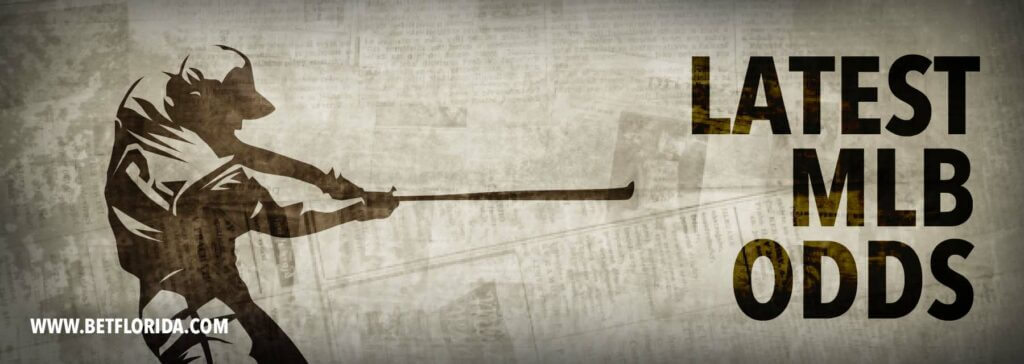The Latest MLB Odds
Let’s get into the excitement that awaits us for the season before we discuss the different types of MLB odds. We’re sure every punter is getting ready to start their sports betting on baseball.
Here at BetFlorida.com you can find the best sportsbooks with the best MLB odds in Florida.

Types of MLB Odds
Online bookmakers offer a variety of odds for MLB games. However, you may have noticed that they don’t always look the same in different sportsbooks. In one, you may find plus and minus symbols, while another shows decimals or fractions.
In this section, we’re going to take a look at the three main systems. Moreover, we’ll also show you how to calculate probabilities and payouts for each system. Read through them to see which method works best for you.
American Odds
American odds are also known as Moneyline or US odds. They have a home among US punters. You’ll instantly recognize it by the plus and minus symbols.
So what do the symbols mean? Well, the minus symbol presents the favorite team to win. Alternatively, the plus symbol indicates the underdog.
Some numbers accompany the signs. These represent how much you’ll need to stake for each team to win $100. To get a better idea of this principle, let’s use an example in an MLB match.
- Miami Marlins +450
- Tampa Bay Rays -600
In this example, the Marlins have a lower probability than the Rays to win the game. If you stake $100 on the Marlins, then you could win $450. However, you must wager $600 on the Rays if you want to win $100.
How to Calculate Probability for American Odds in MLB
You can use the American system to determine the probability of a team winning. Both the plus and minus symbols have a unique formula, which we’ve listed below. The only information that changes during the calculation is the odds at the time of betting.
- Plus formula: [100 / (+odds + 100)] x 100.
- Minus formula: [-odds / (-odds +100)] x 100.
If we use the example figures, then the probabilities of each team winning would be the following:
- Miami: [100 / (450 + 100)] x 100 = 18.18%
- Tampa Bay: [600 / (600 + 100)] x 100 = 85.71%
Formula on How to Calculate payouts
There is also a way to calculate the potential payout of your bet. We’ve already shown you how the values relate to $100 bets or payouts. However, you won’t always stake or win $100. You’ll need to use the $100 as a base while adding your original stake at the end.
- Plus formula: [Stake x (odds/100)] + Stake
- Minus formula: [Stake / (odds/100)] + Stake
Let’s rely on our trusty example again. If you decide to wager $50 on the Marlins or the Rays, your potential payouts are as follows:
- Marlins: [$50 x (450/100)] + $50 = $275
- The Rays: [$50 / (600/100)] + $50 = $58.33
Since the Marlins had less of a possibility of winning, you would receive higher winnings you bet on them, and they won. If you only want to work out your profit, then don’t add your stake at the end of the formula.
Fractional Odds
The word ‘fractional’ gives the game away. Yes, bookmakers represent the values as fractions. While the UK and Ireland are fond of using this system, sportsbooks often provide the ability to switch from American to fractional.
Let’s say you switch our American system example for MLB markets to fractional. The information below is what you would see when the website updates:
- Miami 9/2
- Tampa Bay 1/6
As you can see, positive values reflect with the larger number on the left of the fraction. This fraction indicates the favored team to win. Alternatively, negative values have a smaller number on the left, showing that they are the underdogs of the game.
How to Calculate Probability Based on Fractional Odds
No matter which values you use in this instance, there is only one formula to determine the probability of a team winning. It’s mainly due to how the fraction is structured between plus and minus values. To get the percentage, it’s a simple manipulation of the number ‘1’.
The formula is as follows:
- [1 / {(odds) + 1}] x 100
Therefore, if we applied it to our examples:
- Miami: [1 / {(9/2) + 1}] x 100 = 18.18%
- Tampa Bay: [1 / {(1/6) + 1}] x 100 = 85.71%
It’s evident with the two equations we receive the same probabilities.
How to Calculate Payouts with Fractional Odds
Calculating your payout is easier for the fractional than the American system. It’s the simplicity of the fractions that makes it effortless. To work out your potential payout, multiply your stake with the fraction, and then add your stake at the end.

Here is the formula:
- [Stake x (odds)] + Stake
For the formula to work, you must first divide the first number by the second number before multiplying it with the stake. Ensure that you don’t change the order of the numbers in the fraction. Here you can see how you would apply our MLB match for the potential payout.
- Miami: [$50 x (9/2)] + $50 = $275
- Tampa Bay: [$50 x (1/6)] + $50 = $58.33
Once again, the potential payouts match those calculated with the American system. As with the American system, don’t add your stake at the end if you only want to see your profit.
Decimal Odds
As we’ve highlighted, the United States relies on the American method, and the UK and Ireland use the fractional method. For the rest of the world, there is the decimal system.
You’ve probably guessed that the system uses decimal numbers to represent the chances of winning. The higher the decimal number, the lower the chances of winning.
However, with higher odds, you’ll receive a higher payout if the team wins. If you switched our special MLB game to the decimal system on a bookie’s site, this is what you would see. Remember, you need to round off the decimals to two decimal places.
- Miami 5.50
- Tampa Bay 1.17
Since the Red Sox have a lower value, there is a better chance that the team will win.
Calculating Probability for Decimal Odds
As with the fractional method, there is only one formula to calculate probabilities on the decimal method. This system is the easiest of the three since you only use one number for the odds. All you do is divide 1 by the odds and then multiply by 100.
- (1 / odds) x 100
Although we see the value rounded off to 2 decimal places, you should use the full decimal number in the formula. When we apply the formula to our game, we receive the following probabilities:
- Miami: (1 / 5.50) x 100 = 18.18%
- Tampa Bay: (1 / 1.17) x 100 = 85.47%
It’s due to the inversion of the ‘1’ that the lower odds reflect a higher probability of winning. Thanks to the simplicity of the formula, many punters around the world prefer this method.
How to Calculate Payouts with Decimal Odds
The simplicity of decimals carries through to working out your potential payout. However, in previous equations, you needed to add your stake at the end to determine your payout. In this case, you need to exclude the addition.
This formula below is how you calculate payouts:
- Stake x odds.
So for our MLB match, here are the potential payouts. Use the full decimal numbers for accuracy.
- Miami: $50 x 5.50 = $275
- Tampa Bay: $50 x 1.17 = $58.33
Only in this case do you subtract your stake if you want to calculate your profit. However, if you’d prefer to work it out using a formula, we have you covered.
- Stake x (odds -1)
- Miami: $50 x 4.50 = $225
- Tampa Bay: $50 x 0.17 = $8.33
Understanding Odds
It should be evident to you now that you can calculate the probability of a team winning by using odds. Furthermore, other MLB markets present odds for specific events happening in a match.
For example, the odds of a player scoring a number of home runs during the game.

However, the odds value itself doesn’t reflect probability. You must remember that the bookie’s profit margin is included in the odds. What the odds do reflect is the ratio of the payout to the stake.
Here are a few examples of the different types of odds in MLB sports betting.
Odds in a Money Line
The American odds system gives a clear indication of how the Money Line odds work. You’ll bet on the winner of the match, regardless of the points margin.
The minus shows the favored team to win, with the plus representing the underdog. The bookie calculates beforehand which team is likely to win based on statistics.
As already mentioned, the positive and negative values indicate which team is most likely to win. The plus-value reveals how much you will win for a $100 stake. Alternatively, the minus-value shows how much you need to stake to win $100.
Point Spread Odds
If every punter bet on the winning team to win, then the scales would be unbalanced. To counter this imbalance, the bookie may provide odds for a team winning by a certain margin. It would spread the points, creating a handicap on the favorite team.
Let’s say the bookie decides to place point spread odds of -3.5 for the Tampa Bay to win. The Miami odds would be +3.5. What it means is, if you bet on the Tampa Bay to win, they would need to lead by four points at the end of the game to win your wager.
If you bet that the Miami Marlins win, you would win your wager under the following conditions:
- Miami win;
- Miami draw;
- Tampa Bay win, but do not pass the 3.5 point margin.
Odds in Point Totals
The bookie also provides odds for the total number of points scored in an MLB game. These points are the sum of both team scores, which includes overtime points.
Your objective is to guess whether the game will end with a score over or above the bookmaker’s score. It’s often referred to as an over/under market.
Futures Odds
Bookies also refer to future odds as ante-post and outright odds. You can bet on which team will win the league or world series. Favorites to win have the lowest odds, while the other teams will rise at odds as the possibility of winning lowers.
Unique Odds in MLB
The previous odds systems are available in many other sports, such as soccer. Yet, there are specific odds that are tied explicitly to MLB matches. This method is also known as ‘prop betting.’
We’re going to take a brief look at these.
Player-specific Odds
MLB player prop betting is where you wager on specific player statistics. You can bet on over/under values or select specific numbers. Playoff matches feature many prop bets, mostly due to the stats availability.
Here are a few examples of player prop bets:
- Player to hit a home run;
- Total player hits or runs;
- Most hits by a player in the game;
- Most strikeouts by a pitcher.
Game-specific Odds
You can also bet on team props. These markets look at the game as a whole, instead of player statistics. The team props don’t rely on the final outcome of the match.
Here are some examples of team prop bets:
- The first team to score in the match;
- Total hits and runs in the game; (Make sure to understand the MLB rules for this option)
- Whether any team will score runs in the first innings;
- The total number of home runs in the match.